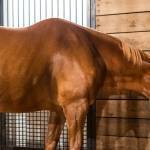Feeding Behavior in Horses: Subtle Changes May Signal Emotional State

Anyone who’s wheeled a hay and grain trolley down a barn aisle knows horses have loud, often thunderous, expectations when it comes to meals—whinnying, banging on stall doors, grating teeth across stall bars, kicking walls.
Anticipation comes in more subtle ways, too, as facial expressions or quieter acts of expectancy. Two researchers at the University of Lincoln, in Lincolnshire, England, set out to identify facial markers indicative of emotional stress in horses through a feeding trial.
Thirty-one horses of mixed ages and genders were trained to anticipate feed and then tested in three feeding scenarios, all involving the potential availability of feed.
The tests were done in a familiar stable with a feeding device fixed on the outside of the stall. All horses were familiarized with the feeding device prior to the study. To train horses to anticipate feed, the researchers poured pellets into the feeder and, after 10 seconds, they were allowed access to the feed. Repeated trials ensured all horses anticipated the arrival of feed, imperative for the study.
For the actual study, the horses were brought into familiar stalls and their reactions video recorded. When each horse came within one meter of the feeder, the feed was released, which signaled the start of one of three tests: (1) anticipation, (2) frustration, or (3) disappointment. Each test was tied to a perceived emotional state: anticipation indicated positive emotional expression, while frustration and disappointment indicated negative emotional states.
The anticipation test consisted of the training protocol mentioned previously: feed was dropped into the feeder, and horses had to wait 10 seconds to gain access to it. The frustration test involved dropping feed, but the feed remained inaccessible for a full minute afterwards. The disappointment test consisted of dropping feed, waiting 10 seconds, but then allowing access to only an empty bucket.
Ten three-second video samples were extracted from the recordings of each horse. The 10 samples included baseline footage, three anticipation phases, three frustration phases, and three disappointment phases. The Horse Facial Action Coding System was used to analyze samples. Frustration, for example, could be indicated by showing the sclera or white of the eye, rotating an ear, or turning the head toward the feed supply. Disappointment, on the other hand, could be signified by lifting the nostrils, chewing, or licking the feeder. Other behaviors were more understated: relaxation of the lower lip, forward or sideways thrust of the jaw, closure of the eyelids, or puckering of the lips.
Analysis revealed some notable differences in behaviors interpreted as frustration and disappointment. Compared to disappointment, frustration was noted by revealing the sclera, rotating an ear, and biting the feeder. Disappointment brought about other behaviors: showing the tongue, chewing, licking the feeder, lifting a nostril, and blinking.
According to the researchers, this study “demonstrates how specific measures of facial expression in the horse can potentially be used to assist the differentiation of the emotional state of the animal.” The researchers were careful to note that these changes may be limited to this particular feeding situation and should not be viewed as universal.
Many times, the most disruptive horses at mealtime are those that do not have free-choice access to forage, so they are, to use common parlance, “hangry.” Free-choice access to forage keeps both the stomach and hindgut content, as gastric ulcers are less likely to form in a full stomach and the hindgut works most efficiently when there is a constant turnover of forage. Check out these research-proven nutritional supplements designed to keep the gastrointestinal tract in fine fettle.
Horse behavior is endlessly fascinating for those that take the time to study it. The minutiae may escape beginner observers—the twitching of a brow, or the lifting of an upper lip—but with time and patience most people will notice subtle changes in their own horse’s expressions. Have a look for yourself!
*Ricci-Bonot, C., and D.S. Mills. 2023. Recognising the facial expression of frustration in the horse during the feeding period. Applied Animal Behaviour Science 265:105966.








